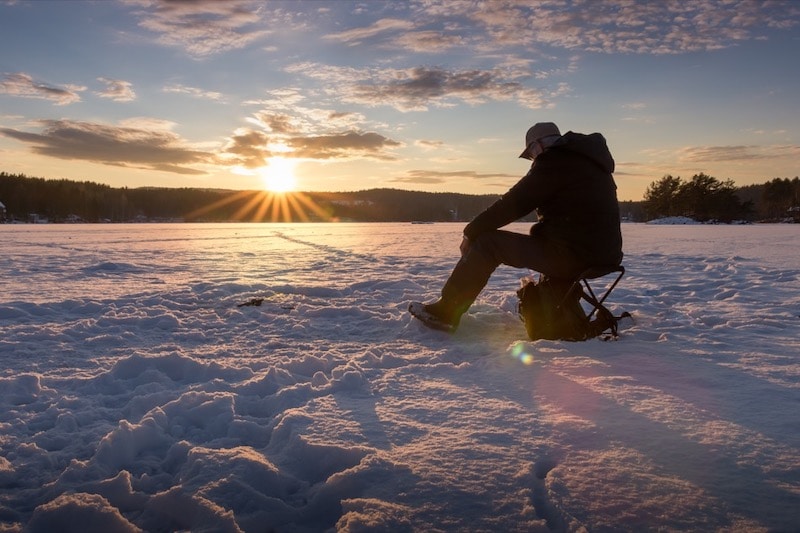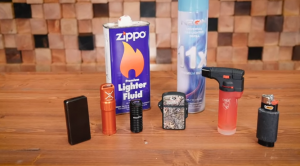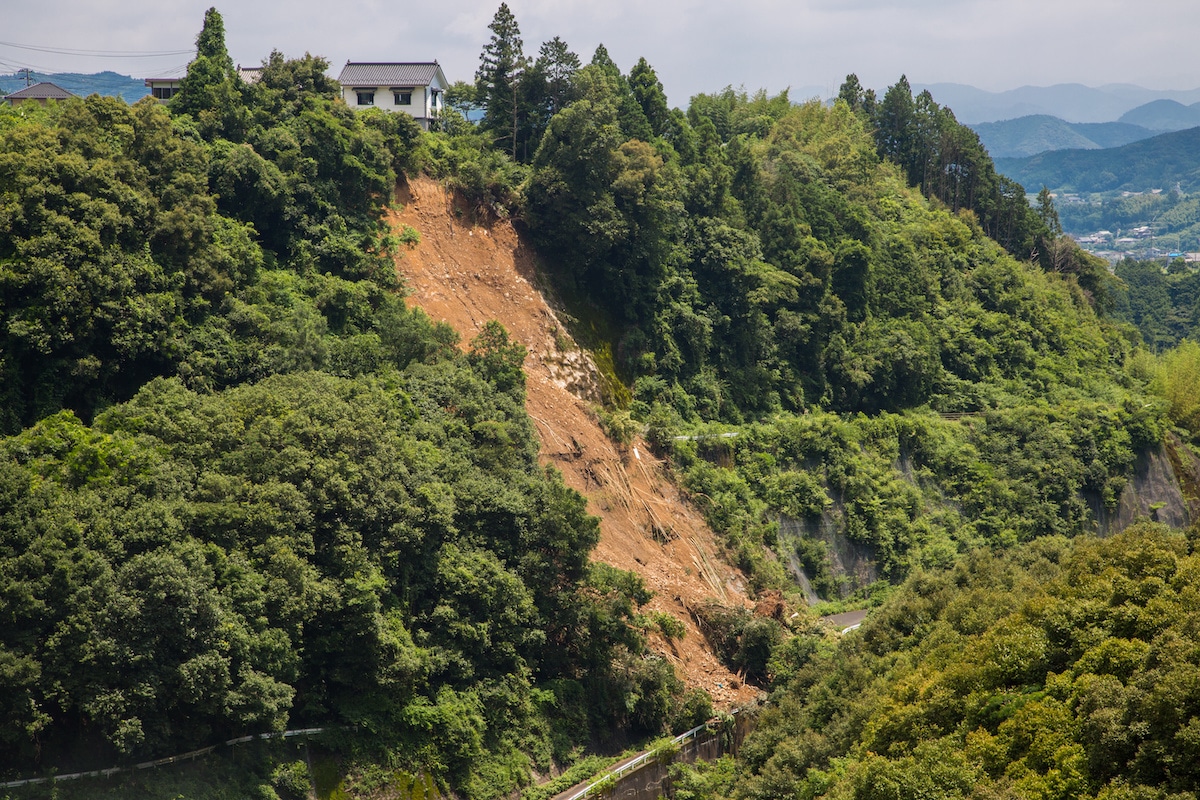People have leaned on ice fishing as a way to obtain food for a long time. The practice of ice fishing is native to the early residents of North America. Back in the day, the people taking part in ice fishing would use wooden decoys shaped like fish to lure in their prey. Once a fish approached the decoy, the fishermen would use a primitive spear to catch the fish. The old spears were fashioned out of materials such as bone, ivory, or wood.
What We'll Cover
- Never Go Ice Fishing Alone
- Understanding the Ice
- What to Wear When You Go Ice Fishing
- The Preparations to Make Before Ice Fishing
- Pinpoint a Suitable Fishing Spot
- Pick Up Some Ice Fishing Essentials
- Baits, Reels, and Rods
- Some Additional Reminders
- How to Create a Fishing Hole in the Ice
- Different Fishing Methods
- Conclusion
Our tools for ice fishing have changed over the years. Newer ice fishing techniques have also been developed. What has remained constant though is the enjoyment you can get from a day of fishing. If you’ve ever wanted to try out ice fishing yourself, then you’re in luck as this will supply you with all the essential information you need to get started.
Never Go Ice Fishing Alone
Arguably the most important safety tip for ice fishing is to simply avoid taking part in the activity by yourself. Remember you are venturing into a harsh environment when you go ice fishing. One wrong step and you can fall into the freezing water. With no one around to pull you out of the water or even just hear your cries for help, things will take a turn for the worse in a hurry.
You should also let others know if you’re going ice fishing and tell them your exact location. Should something happen that puts your entire fishing group in danger, having others know about your whereabouts could turn out to be a huge help.
Understanding the Ice
The ice is the only thing protecting you from the freezing waters. You must be certain it is capable of supporting you as you’re fishing. Generally speaking, you should only fish when the ice is at least 4 inches thick. Anything thinner than that and you are putting yourself at serious risk for falling through.
Do note the ice thickness recommendation above only applies to clear, solid ice. White ice is not as strong and it will have to be twice as thick to provide support comparable to what solid ice offers.
Another important thing to note here is ice does not form evenly. Make sure you re-check the thickness of the ice you’re standing on whenever you move from one location to the next.
How to Check the Thickness of the Ice
Different tools can be used for checking the thickness of the ice. You can use an auger, a chisel or, a drill for this job and they will all work great.
Before inserting your tool of choice into the ice, make sure it is properly marked. Mark the spot where the tool will reach 4 inches into the ice. See if this mark is hit when you plunge the tool into the ice. If the mark is hit or reaches even higher, then you’re good to go. Otherwise, carefully move to a different spot.
What to Wear When You Go Ice Fishing
Going ice fishing means having to subject yourself to the frigid winter air. Needless to say, this can become uncomfortable in a hurry unless you’re wearing the right clothes.
Let’s start with what you need to wear on your feet. You basically have no other choice than to wear boots. Search for waterproof boots and make sure they have thick inner layers to help keep your feet warm. The boots should also be able to maintain a firm grip on the icy surface. Alternatively, you can pair some cleats together with your boots to establish a better hold on the ice.
When it comes to socks, you will have to be picky again. Cotton socks will not do enough to keep you warm on the ice. You must reach for fleece, wool, or synthetic socks if you’re going ice fishing.
For your legs, you should layer your clothing. Long underwear made from the same materials mentioned above should work well in this scenario. You should also put on something warm over your long underwear. Sweatpants are going to serve you well here. Put some kneepads over your sweatpants to ensure your joints remain adequately protected as you’re bending down on the ice. Try layering again when choosing what to wear over your torso. Focus first on finding a shirt that can keep moisture away from your skin. After that, you can pile on layers of shirts made from warm materials.
Polyester and spandex are great material choices for your shirts because they will keep you warm without absorbing excessive amounts of moisture. Complete your ice fishing outfit by wearing a skull cap and some gloves.
Important Pieces of Survival Gear
Staying safe on the ice requires more than just wearing the right outfit. You will also have to bring specific tools to potentially get you out of some tough spots.
One such tool is an emergency throw rope. An emergency throw rope comes with a component keeping the rope free from tangles and adds weight to it. This additional component makes the emergency throw rope better suited for rescuing people.
You should also bring a flotation device along with the rope. If you’re having trouble trying to pull someone out of the freezing water, the flotation device can help him/her as you go look for others who can help.
It’s also a good idea to bring a GPS device with you for your fishing trip. In an emergency situation, a GPS device can help others find you faster.
The Preparations to Make Before Ice Fishing
Prior to setting any plans for your ice fishing excursion, it would be in your best interest to first obtain a fishing license. The requirements for obtaining one vary from one state to the next. You should first head to your state’s Department of Natural Resources if you want to get the ball rolling on your fishing license. They will be able to tell you the requirements you need to provide and the steps you must take next.
Pinpoint a Suitable Fishing Spot
Location matters not just if you’re looking for a good real estate property to invest in. It’s also an important factor to consider when you’re ice fishing. There are certain qualities to define a good fishing spot.
Spots near underwater rock formations are often teeming with fish. This is because larger fish tend to use these spots for catching prey of their own. Think of it as their hunting grounds.
Inlets and outlets also make for great ice fishing spots, but it is obviously difficult to find them under cover of ice. You should look for these spots prior to the start of winter and remember them so that they are easier to find once the ice forms.
Spots near springs are also popular for fish and it’s worth scouting them out if you want to come home with a bounty of fresh seafood.
Pick Up Some Ice Fishing Essentials
Now it’s time to discuss the tools you need to bring with you during your ice fishing expedition. You can start with the tool known as the ice spud or spud bar. The ice spud is not necessarily something you use while fishing. Instead, it’s a tool that can help you measure the thickness of the ice. It will also come in handy if you’re moving on top of the ice as it can serve as a kind of walking stick.
Augers are similarly good to have on hand for ice fishing. The auger is the tool many people use to drill holes into the ice. Augers generally fall into one of two categories – hand augers and power augers. The hand augers are better to use if you prefer a quiet and cleaner tool, while power augers are for faster drilling.
Ice scoops are not quite as important as the two aforementioned tools, but it still deserves a spot in your gear. You can use the ice scoop to clean out the fishing hole and create something easier for you and your companions to fish in.
Baits, Reels, and Rods
The key to hooking the right type of fish is to have the right combination of bait, reel, rod, and fishing pliers in your tackle box. Examples of bait yielding great results during ice fishing include corn kernels, marshmallows, minnows, and different types of worms. Double check if the bait you want to use is permitted in your state before placing it in the water.
You can continue to use your normal reels for ice fishing, but if you have some money to spare, springing for an ice reel is a good move too. Ice reels are often smaller in size than conventional reels, making them better for ice fishing.
Most of the rods specifically designed for ice fishing are also smaller than their more traditional counterparts. There are also different types of ice fishing rods and braided fishing line in different colors for you to choose from.
Some Additional Reminders
Err on the side of caution when you’re making preparations for the upcoming ice fishing trip. Go ahead and wear an extra layer of clothing because you can always take that off. Not having enough clothes to keep yourself warm would be a bigger issue in this scenario.
You must also pack some food and water for your trip. No ice fishing trip is guaranteed to provide a good haul, but packing a fillet knife so you can prep and clean the fish just in case doesn’t hurt. Protect against the onset of hunger and dehydration by keeping food and water in your vehicle.
How to Create a Fishing Hole in the Ice
To get started on creating a fishing hole, you should first pick out your ideal spot. Once you’ve made your way to this location, proceed to examine the thickness of the ice using an auger, a chisel, or a drill. Remember the ice must be at least 4 inches thick to support you properly.
After determining the spot has thick enough ice, you can start to use your tool of choice to burrow into it. Keep going until you hit the water. You can also create multiple holes and use them simultaneously for fishing if you prefer.
Clean up the excess ice around the hole before you start fishing so the crystals don’t fall in and scare the fishes away.
Different Fishing Methods
Most fishermen will use either rods or traps when they go fishing. You probably know at least a little something about rods, but the traps may not be as familiar.
Traps function similarly to rods because they attract fish using bait. Once a fish grabs onto the bait, a spool of line will spin out and the trap will release a flag letting a fisherman know a fish has been caught. The fisherman can then set the trap aside and pull up the fish along with the line. Traps are better for catching larger fish.
Going back to rods, you can figure out which one will suit you best by checking out its power. Rod power can be classified into ultra-light, light, medium, and heavy. The rule of thumb is the more powerful it is, the better it will be for catching bigger fishes.
Primitive Ice Fishing Methods
Do you want to try out a simpler method of ice fishing? Then perhaps spearfishing or clubbing will be more up your alley.
Spearfishing can be difficult because spotting the fish underwater is no easy feat. Preferably, you should spearfish within an enclosed space or at least put some type of covering over you. Next, tie the spear you’re using to something stable or even to your leg with a rope. You will need some bait or various fishing tackle to lure the fish closer to your waiting area as well. Once a fish comes into view, position the spear vertically, line up your shot, and then throw the spear at the fish. If you did everything right, you should be able to pull the fish out of the water using the rope.
You can also resort to clubbing as a method for ice fishing. This involves using a large club to whack the ice directly on top of a fish. After clubbing the ice, the fish should become temporarily stunned. You can then cut a hole into the ice to take the fish out of the water.
A Few Reminders for Successful Ice Fishing
Unless you plan to use the clubbing method, your success while ice fishing will rely largely on what kind of bait you decide to use. Take the time to sort through the available options and remember different types of bait attract different types of fish.
Worms will work on just about any kind of fish, but if you’re eyeing trout specifically, marshmallows are the better choice. Check to see what types of fish are present in your area and pick the bait to appeal most to them.
Conclusion
Ice fishing is riskier than some hobbies, so it’s important to use the right tools and take the proper precautions. It’s well worth the trouble because being able to feast on fresh fish in the middle of winter is a real luxury worth experiencing.
The responses below are not provided, commissioned, reviewed, approved, or otherwise endorsed by any financial entity or advertiser. It is not the advertiser’s responsibility to ensure all posts and/or questions are answered.



![Best Archery Sets This 2023 [Men & Women]](/assets/images/8cf78150f1d9d7a0c175609145d21517.png)

